MITSUBISHI MIRAGE G4 2020 Owner's Manual (in English)
Manufacturer: MITSUBISHI, Model Year: 2020, Model line: MIRAGE G4, Model: MITSUBISHI MIRAGE G4 2020Pages: 253, PDF Size: 36.39 MB
Page 121 of 253

Cruise control (if so equipped) 5-56 Features and controls
5
N00518500344
There are 2 ways to increase the set speed. Press and hold the RES + switch (C) while driving at the set speed, and your speed will then gradually increase.When you reach your desired speed, release the switch. Your new cruising speed is now set.
To increase your speed in small amounts, press the RES + switch for less than about 1second and release it. Each time you press the RES + switch, your vehicle will go about 1 mph (1.6 km/h) faster. While driving at the set speed, use the accel- erator pedal to reach
your desired speed and
then press the SET - sw
itch (B) and release
the switch momentarily to set a new desiredcruising speed.
N00518600273
There are 2 ways to decrease the set speed.
Press and hold the SET - switch (B) while driving at the set speed, and your speed will slow down gradually.When you reach your desired speed, release the switch. Your new
cruising speed is now
set. To slow down your sp
eed in small amounts,
press the SET - switch for less than about 1 second and release it. Each time you press the SET - switch, yourvehicle will sl
ow down by about 1 mph (1.6
km/h). While driving at the set speed, use the brake pedal, which disengage
s the cruise control,
NOTE
When you release the SET - switch, the vehi- cle speed will be set.
To increase the set speed
RES + switch
Accelerator pedal
To decrease the set speed
SET - switch
Brake pedal
BK0284300US.book 56 ページ 2019年5月23日 木曜日 午後12時22分
Page 122 of 253
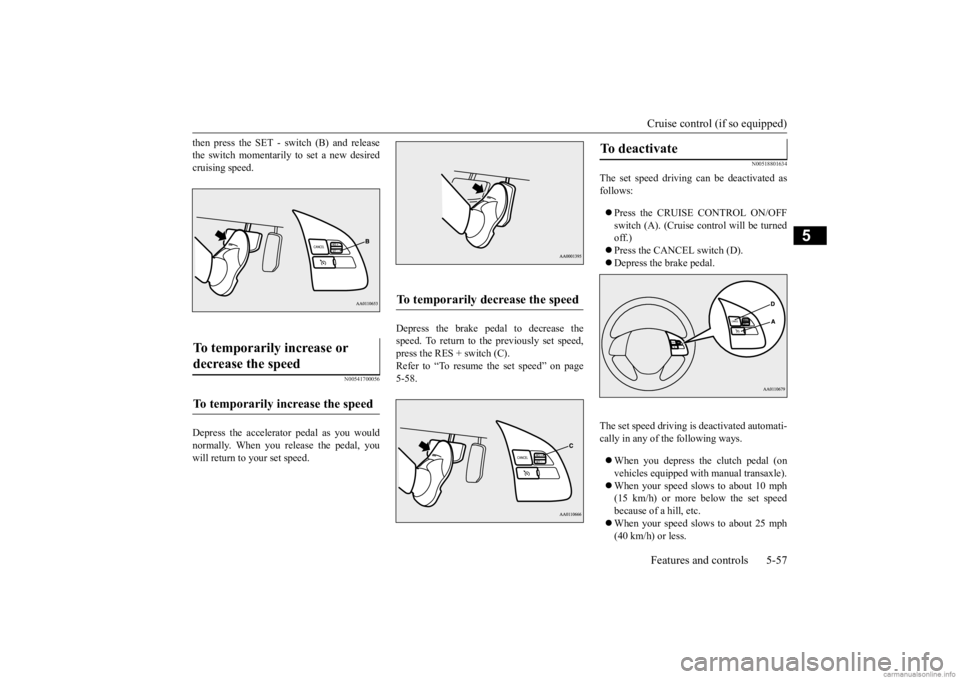
Cruise control (if so equipped) Features and controls 5-57
5
then press the SET - sw
itch (B) and release
the switch momentarily to set a new desiredcruising speed.
N00541700056
Depress the accelerator pedal as you wouldnormally. When you release the pedal, you will return to your set speed.
Depress the brake pedal to decrease the speed. To return to the previously set speed, press the RES + switch (C). Refer to “To resume the set speed” on page5-58.
N00518801634
The set speed driving can be deactivated as follows: Press the CRUISE CONTROL ON/OFF switch (A). (Cruise control will be turnedoff.) Press the CANCEL switch (D). Depress the brake pedal.
The set speed driving is
deactivated automati-
cally in any of the following ways. When you depress the clutch pedal (on vehicles equipped w
ith manual transaxle).
When your speed slows to about 10 mph (15 km/h) or more below the set speed because of a hill, etc. When your speed slows to about 25 mph (40 km/h) or less.
To temporarily increase or decrease the speed
To temporarily increase the speed
To temporarily decrease the speed
To deactivate
BK0284300US.book 57 ページ 2019年5月23日 木曜日 午後12時22分
Page 123 of 253
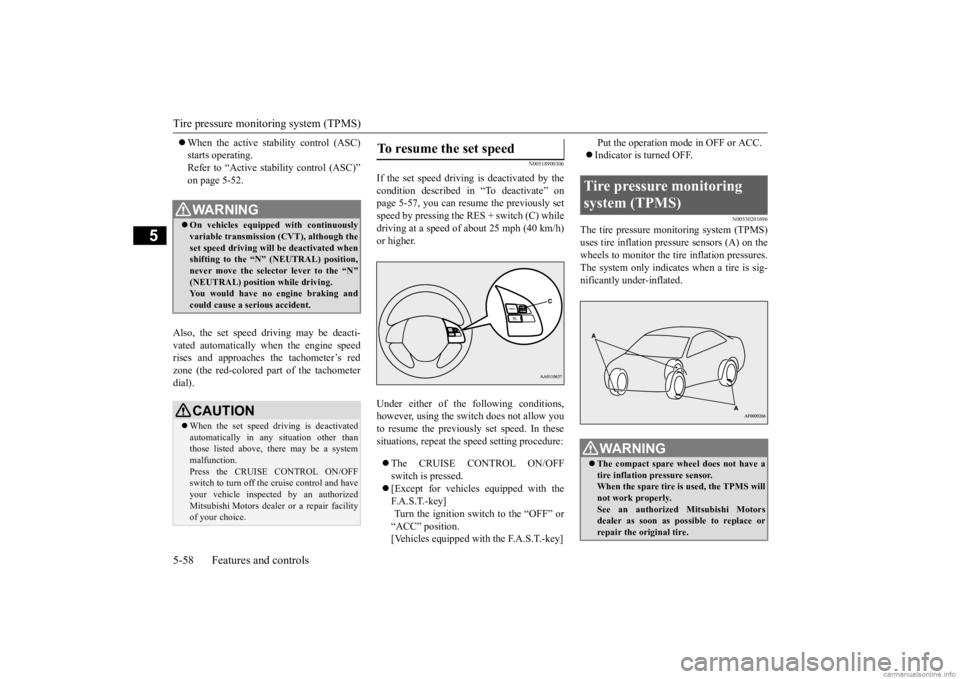
Tire pressure monitoring system (TPMS) 5-58 Features and controls
5
When the active stability control (ASC) starts operating.Refer to “Active stab
ility control (ASC)”
on page 5-52.
Also, the set speed driving may be deacti- vated automatically when the engine speed rises and approaches the tachometer’s redzone (the red-colored part of the tachometer dial).
N00518900306
If the set speed driving is deactivated by thecondition described in “To deactivate” on page 5-57, you can resu
me the previously set
speed by pressing the RES + switch (C) while driving at a speed of about 25 mph (40 km/h) or higher. Under either of the
following conditions,
however, using the sw
itch does not allow you
to resume the previously set speed. In these situations, repeat the
speed setting procedure:
The CRUISE CONTROL ON/OFF switch is pressed. [Except for vehicles equipped with the F. A . S . T. - k e y ] Turn the ignition switch to the “OFF” or “ACC” position. [Vehicles equipped with the F.A.S.T.-key]
Put the operation mode in OFF or ACC. Indicator is turned OFF.
N00530201696
The tire pressure moni
toring system (TPMS)
uses tire inflation pre
ssure sensors (A) on the
wheels to monitor the ti
re inflation pressures.
The system only indicates when a tire is sig- nificantly under-inflated.
WA R N I N G On vehicles equipped with continuously variable transmis
sion (CVT), although the
set speed driving will be deactivated whenshifting to the “N”
(NEUTRAL) position,
never move the select
or lever to the “N”
(NEUTRAL) position while driving.You would have no engine braking and could cause a serious accident.CAUTION When the set speed dr
iving is deactivated
automatically in any
situation other than
those listed above, there may be a systemmalfunction. Press the CRUISE CONTROL ON/OFF switch to turn off the
cruise control and have
your vehicle inspecte
d by an authorized
Mitsubishi Motors dealer
or a repair facility
of your choice.
To resume the set speed
Tire pressure monitoring system (TPMS)
WA R N I N G The compact spare wheel does not have a tire inflation pressure sensor. When the spare tire is used, the TPMS willnot work properly. See an authorized
Mitsubishi Motors
dealer as soon as po
ssible to replace or
repair the original tire.
BK0284300US.book 58 ページ 2019年5月23日 木曜日 午後12時22分
Page 124 of 253
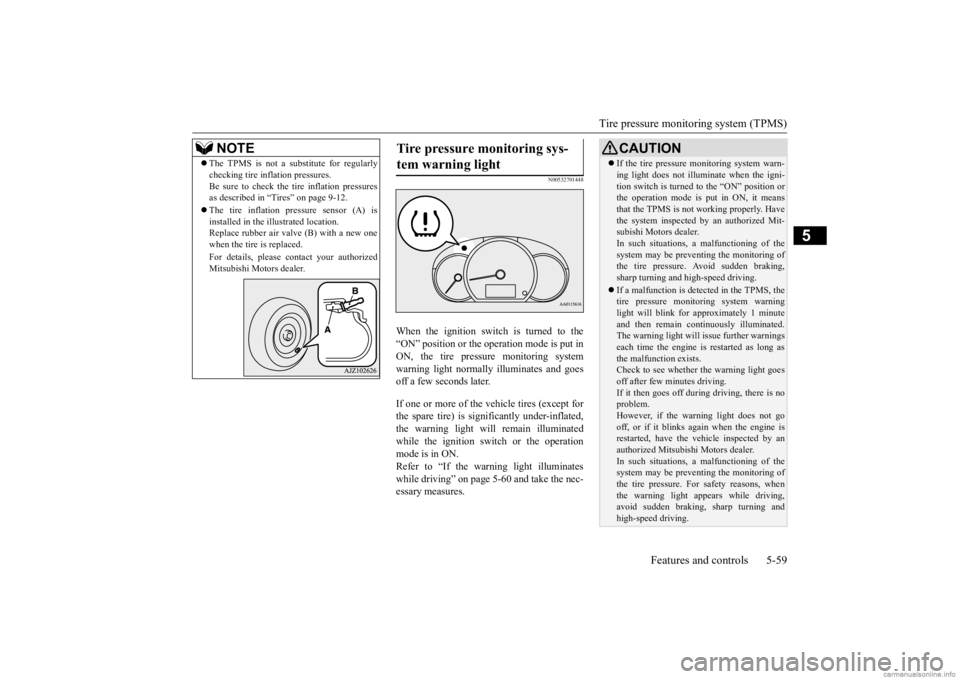
Tire pressure monitoring system (TPMS)
Features and controls 5-59
5
N00532701448
When the ignition switch is turned to the “ON” position or the ope
ration mode is put in
ON, the tire pressure monitoring system warning light normally
illuminates and goes
off a few seconds later. If one or more of the vehicle tires (except for the spare tire) is signi
ficantly under-inflated,
the warning light will remain illuminated while the ignition switch or the operationmode is in ON. Refer to “If the warning light illuminates while driving” on page 5-60 and take the nec-essary measures.
NOTE
The TPMS is not a substitute for regularly checking tire inflation pressures.Be sure to check the tire inflation pressuresas described in “Tires” on page 9-12. The tire inflation pressure sensor (A) is installed in the illustrated location. Replace rubber air valve (B) with a new one when the tire is replaced. For details, please
contact your authorized
Mitsubishi Motors dealer.
Tire pressure monitoring sys- tem warning light
CAUTION If the tire pressure monitoring system warn- ing light does not illumi
nate when the igni-
tion switch is turned to the “ON” position orthe operation mode is put in ON, it means that the TPMS is not working properly. Have the system inspected by an authorized Mit-subishi Motors dealer. In such situations, a malfunctioning of the system may be preventing the monitoring ofthe tire pressure. Avoid sudden braking, sharp turning and high-speed driving. If a malfunction is detected in the TPMS, the tire pressure monitoring system warning light will blink for a
pproximately 1 minute
and then remain cont
inuously illuminated.
The warning light will issue further warnings each time the engine
is restarted as long as
the malfunction exists. Check to see whether the warning light goes off after few minutes driving.If it then goes off during driving, there is no problem. However, if the warning light does not gooff, or if it blinks again when the engine is restarted, have the
vehicle inspected by an
authorized Mitsubish
i Motors dealer.
In such situations, a malfunctioning of the system may be preventing the monitoring of the tire pressure. For safety reasons, whenthe warning light appears while driving, avoid sudden braking, sharp turning and high-speed driving.
BK0284300US.book 59 ページ 2019年5月23日 木曜日 午後12時22分
Page 125 of 253

Tire pressure monitoring system (TPMS) 5-60 Features and controls
5
Each tire, including the spare, should be checked monthly when cold and inflated tothe inflation pressure recommended by the vehicle manufac
turer on the vehicle placard
or tire inflation pressu
re label. (If your vehi-
cle has tires of a different size than the size indicated on the vehicle
placard or tire infla-
tion pressure label, yo
u should determine the
proper tire inflation pr
essure for those tires.)
As an added safety feature, your vehicle has been equipped with a tire pressure monitoring system (TPMS) that illuminates a low tire pressure telltale when
one or more of your
tires is significant
ly under-inflated.
Accordingly, when the low tire pressure tell- tale illuminates, you should stop and checkyour tires as soon as possible, and inflate them to the proper pressure. Driving on a sig- nificantly under-inflated
tire causes the tire to
overheat and can lead
to tire failure.
Under-inflation also reduces fuel efficiency and tire tread life, and may affect the vehi-cle’s handling and stopping ability. Please note that the TPMS is not a substitute for proper tire maintenance, and it is the driver’sresponsibility to mainta
in correct tire pres-
sure, even if under-inf
lation has not
reached
the level to trigger illumination of the TPMSlow tire pressure telltale. Your vehicle has also been equipped with a TPMS malfunction indicator to indicate when
the system is not operating properly. The TPMS malfunction indicator is combinedwith the low tire pressure telltale. When the system detects a malfunction, the telltale will flash for approximately one min-ute and then remain c
ontinuously illuminated.
This sequence will c
ontinue upon subsequent
vehicle start-ups as long as the malfunctionexists. When the malfunction indicator is illumi- nated, the system may not
be able to detect or
signal low tire pr
essure as intended.
TPMS malfunctions may
occur for a variety
of reasons, including the installation of replacement or alternate tires or wheels on the vehicle that prevent the TPMS from function-ing properly. Always
check the TPMS mal-
function telltale after replacing one or more tires or wheels on your vehicle to ensure thatthe replacement or alternate tires and wheels allow the TPMS to continue to function prop- erly.
N00532801612
1. If the tire pressure monitoring systemwarning light illum
inates, avoid hard
braking, sharp steering maneuvers and high speeds. You should stop and adjust the tires to the proper inflation pressure assoon as possible. Adjust the spare tire at the same time. Refer to “Tires” on page 9-12.
If the warning light illuminates while driving
NOTE
When inspecting or adjusting the tire pres- sure, do not apply excessive force to the valve stem to
avoid breakage.
After inspecting or adjusting the tire pres- sure, always reinstall the valve cap on thevalve stem. Without the valve cap, di
rt or moisture could
get into the valve, resulting in damage to thetire inflation pressure sensor. Do not use metal valve caps, which may cause a metal reaction,
resulting in corrosion
and damage of the tire
inflation pressure sen-
sors. Once adjustments have
been made, the warn-
ing light will go off after a few minutes ofdriving.
BK0284300US.book 60 ページ 2019年5月23日 木曜日 午後12時22分
Page 126 of 253
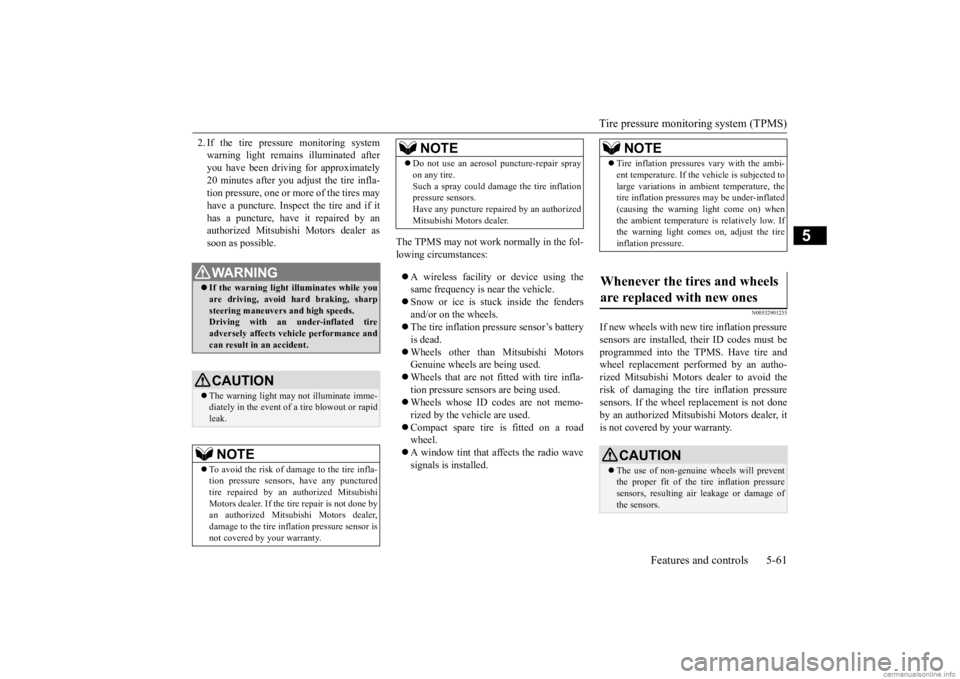
Tire pressure monitoring system (TPMS)
Features and controls 5-61
5
2. If the tire pressure monitoring system warning light remain
s illuminated after
you have been drivi
ng for approximately
20 minutes after you adjust the tire infla- tion pressure, one or more of the tires mayhave a puncture. Inspect the tire and if it has a puncture, have it repaired by an authorized Mitsubishi Motors dealer assoon as possible.
The TPMS may not work normally in the fol- lowing circumstances: A wireless facility
or device using the
same frequency is near the vehicle. Snow or ice is stuck inside the fenders and/or on the wheels. The tire inflation pressure sensor’s battery is dead. Wheels other than Mitsubishi Motors Genuine wheels are being used. Wheels that are not fitted with tire infla- tion pressure sensors are being used. Wheels whose ID codes are not memo- rized by the vehicle are used. Compact spare tire is fitted on a road wheel. A window tint that af
fects the radio wave
signals is installed.
N00532901235
If new wheels with new tire inflation pressure sensors are installed,
their ID codes must be
programmed into the TPMS. Have tire and wheel replacement performed by an autho-rized Mitsubishi Motors dealer to avoid the risk of damaging the tire inflation pressure sensors. If the wheel replacement is not doneby an authorized Mits
ubishi Motors dealer, it
is not covered by your warranty.
WA R N I N G If the warning light illuminates while you are driving, avoid ha
rd braking, sharp
steering maneuvers and high speeds. Driving with an under-inflated tire adversely affe
cts vehicle performance and
can result in an accident.CAUTION The warning light may
not illuminate imme-
diately in the event of
a tire blowout or rapid
leak.NOTE
To avoid the risk of da
mage to the tire infla-
tion pressure sensors, have any puncturedtire repaired by an authorized Mitsubishi Motors dealer. If the tir
e repair is not done by
an authorized Mitsubishi Motors dealer,damage to the tire infl
ation pressure sensor is
not covered by your warranty.
Do not use an aerosol puncture-repair spray on any tire.Such a spray could dama
ge the tire inflation
pressure sensors. Have any puncture repa
ired by an authorized
Mitsubishi Moto
rs dealer.
NOTE
NOTE
Tire inflation pressures vary with the ambi- ent temperature. If the vehicle is subjected tolarge variations in ambient temperature, thetire inflation pressures may be under-inflated (causing the warning light come on) when the ambient temperature is relatively low. Ifthe warning light comes on, adjust the tire inflation pressure.
Whenever the tires and wheels are replaced with new ones
CAUTION The use of non-genuine wheels will prevent the proper fit of the tire inflation pressure sensors, resulting air
leakage or damage of
the sensors.
BK0284300US.book 61 ページ 2019年5月23日 木曜日 午後12時22分
Page 127 of 253
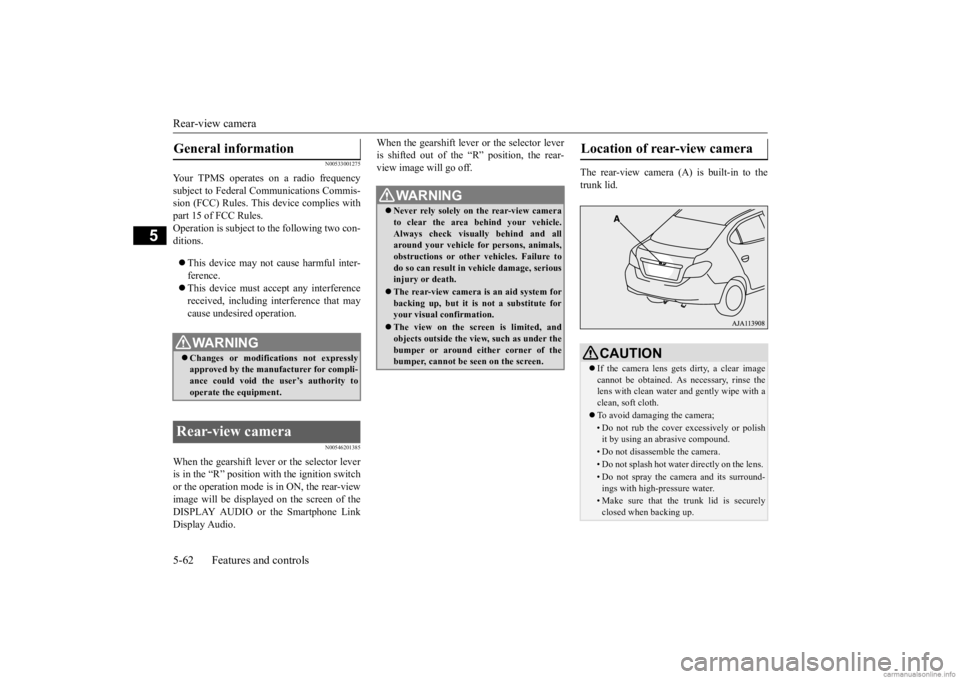
Rear-view camera 5-62 Features and controls
5
N00533001275
Your TPMS operates
on a radio frequency
subject to Federal Communications Commis- sion (FCC) Rules. This device complies withpart 15 of FCC Rules. Operation is subject to the following two con- ditions. This device may not
cause harmful inter-
ference. This device must ac
cept any interference
received, including interference that may cause undesired operation.
N00546201385
When the gearshift lever or the selector lever is in the “R” position with the ignition switchor the operation mode is in ON, the rear-view image will be displayed on the screen of the DISPLAY AUDIO or the Smartphone LinkDisplay Audio.
When the gearshift lever or the selector lever is shifted out of the “R” position, the rear-view image will go off.
The rear-view camera (A) is built-in to the trunk lid.
General information
WA R N I N G Changes or modifications not expressly approved by the manufacturer for compli-ance could void the
user’s authority to
operate the equipment.
Rear-view camera
WA R N I N G Never rely solely on the rear-view camera to clear the area behind your vehicle.Always check visually behind and all around your vehicle fo
r persons, animals,
obstructions or other vehicles. Failure todo so can result in
vehicle damage, serious
injury or death. The rear-view camera is an aid system for backing up, but it is not a substitute for your visual confirmation. The view on the screen is limited, and objects outside the view, such as under thebumper or around either corner of the bumper, cannot be seen on the screen.
Location of rear-view camera
CAUTION If the camera lens gets
dirty, a clear image
cannot be obtained. As
necessary, rinse the
lens with clean water a
nd gently wipe with a
clean, soft cloth. To avoid damaging the camera;• Do not rub the cover excessively or polish it by using an abrasive compound. • Do not disassemble the camera.• Do not splash hot wate
r directly on the lens.
• Do not spray the camera and its surround- ings with high-pressure water.• Make sure that the trunk lid is securelyclosed when backing up.
BK0284300US.book 62 ページ 2019年5月23日 木曜日 午後12時22分
Page 128 of 253
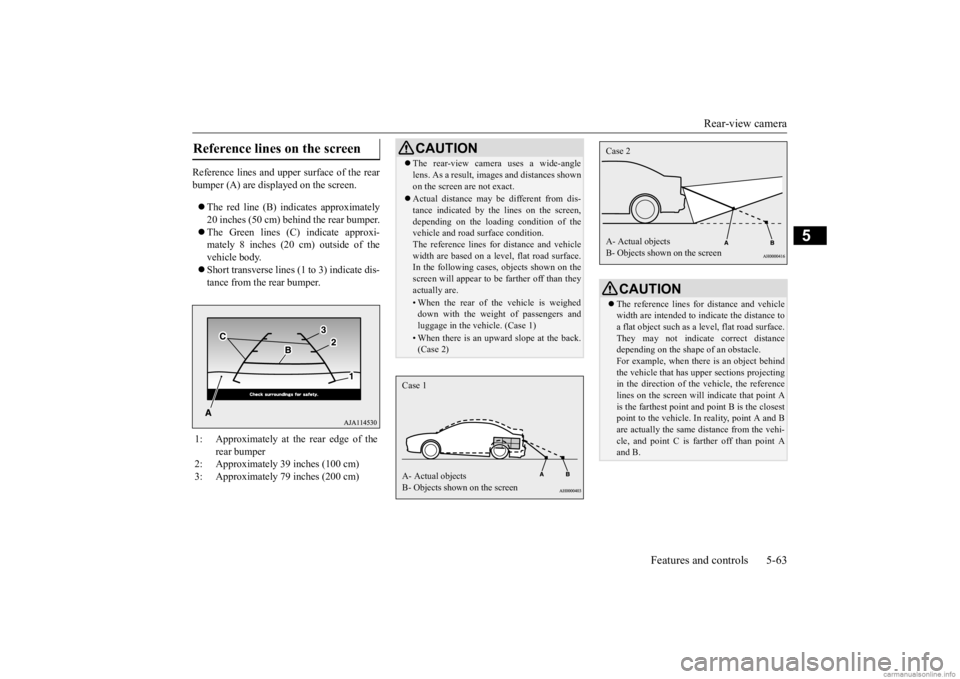
Rear-view camera
Features and controls 5-63
5
Reference lines and upper surface of the rear bumper (A) are displayed on the screen. The red line (B) i
ndicates approximately
20 inches (50 cm) behind the rear bumper. The Green lines (C) indicate approxi- mately 8 inches (20 cm) outside of the vehicle body. Short transverse lines (1 to 3) indicate dis- tance from the rear bumper.
Reference lines on the screen 1: Approximately at the rear edge of the
rear bumper
2: Approximately 39 inches (100 cm) 3: Approximately 79 inches (200 cm)
CAUTION The rear-view camera uses a wide-angle lens. As a result, imag
es and distances shown
on the screen are not exact. Actual distance may
be different from dis-
tance indica
ted by the lines on the screen,
depending on the loading condition of the vehicle and road
surface condition.
The reference lines for
distance and vehicle
width are based on a level, flat road surface. In the following cases, objects shown on the screen will appear to be farther off than theyactually are.• When the rear of the vehicle is weigheddown with the weight of passengers and luggage in the ve
hicle. (Case 1)
• When there is an upward slope at the back. (Case 2)
Case 1 A- Actual objects B- Objects shown on the screen
CAUTION The reference lines for distance and vehicle width are intended to i
ndicate the distance to
a flat object such as a level, flat road surface. They may not indica
te correct distance
depending on the shape of an obstacle.For example, when ther
e is an object behind
the vehicle that has uppe
r sections projecting
in the direction of the vehicle, the referencelines on the screen will
indicate that point A
is the farthest point a
nd point B is the closest
point to the vehicle. In
reality, point A and B
are actually the same distance from the vehi- cle, and point C is fa
rther off than point A
and B.Case 2 A- Actual objects B- Objects shown on the screen
BK0284300US.book 63 ページ 2019年5月23日 木曜日 午後12時22分
Page 129 of 253
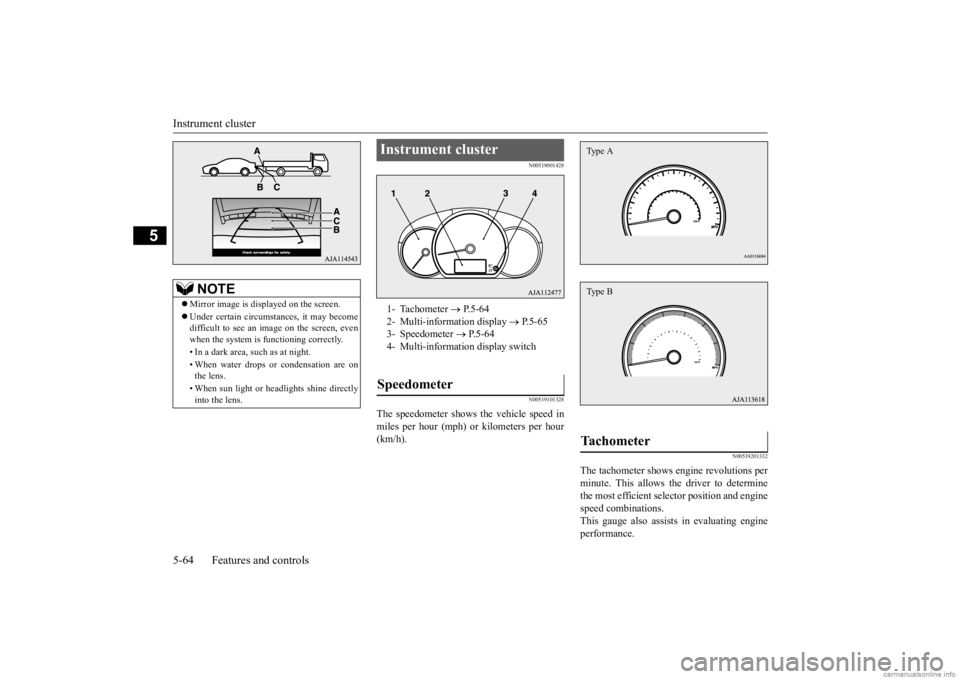
Instrument cluster 5-64 Features and controls
5
N00519001428 N00519101328
The speedometer shows the vehicle speed in miles per hour (mph) or kilometers per hour (km/h).
N00519201332
The tachometer shows e
ngine revolutions per
minute. This allows the driver to determine the most efficient selector position and engine speed combinations.This gauge also assists in evaluating engine performance.
NOTE
Mirror image is displayed on the screen. Under certain circumst
ances, it may become
difficult to see an image on the screen, even when the system is functioning correctly. • In a dark area, such as at night. • When water drops or condensation are on the lens. • When sun light or he
adlights shine directly
into the lens.
Instrument cluster 1- Tachometer
P.5-64
2- Multi-information display
P.5-65
3- Speedometer
P.5-64
4- Multi-information display switchSpeedometer
Tachometer Type AType B
BK0284300US.book 64 ページ 2019年5月23日 木曜日 午後12時22分
Page 130 of 253
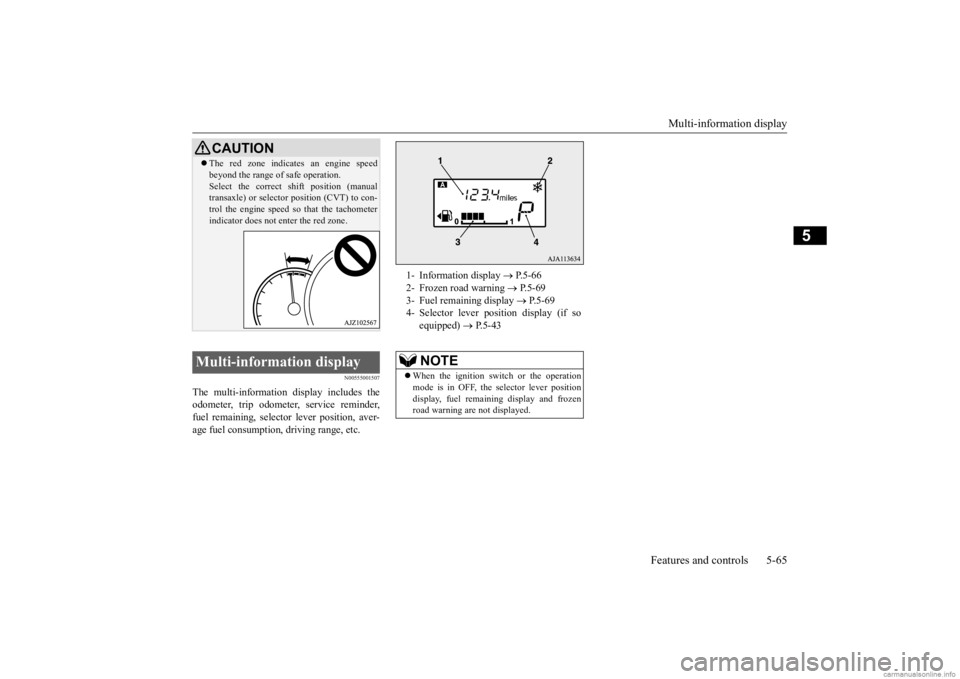
Multi-information display
Features and controls 5-65
5
N00555001507
The multi-information display includes the odometer, trip odometer, service reminder, fuel remaining, selector lever position, aver- age fuel consumption, driving range, etc.
CAUTION The red zone indicates an engine speed beyond the range of safe operation.Select the correct sh
ift position (manual
transaxle) or selector position (CVT) to con- trol the engine speed
so that the tachometer
indicator does not en
ter the red zone.
Multi-information display
1- Information display
P.5-66
2- Frozen road warning
P. 5 - 6 9
3- Fuel remaining display
P.5-69
4- Selector lever po
sition display (if so
equipped)
P.5-43
NOTE
When the ignition swit
ch or the operation
mode is in OFF, the
selector lever position
display, fuel remaining display and frozen road warning are not displayed.
BK0284300US.book 65 ページ 2019年5月23日 木曜日 午後12時22分